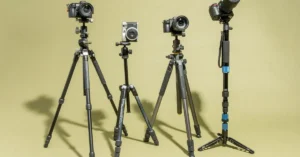Introduction
A tripod is one of the most important tools for photographers, whether you’re an amateur or a seasoned pro. Think of it as the reliable support system for your camera, ensuring that your shots are stable, sharp, and perfectly composed. But not all tripods are created equal, and choosing the right one for your needs can feel overwhelming with so many options out there. In this guide, we’ll break down how to choose and use the perfect tripod camera so you can take your photography to the next level.
The Benefits of Using a Tripod
Before diving into the nitty-gritty of tripod features, let’s talk about why you even need one. Using a tripod helps you achieve stability, sharpness, and consistency in your photos. Whether you’re shooting long exposures, capturing fine details, or working with slow shutter speeds, a tripod eliminates camera shake and allows for precise control.
- Stability: No more blurry photos due to shaky hands.
- Sharpness: When your camera is stable, every detail is captured crisply.
- Consistency: Your framing remains unchanged, making it easy to take multiple shots with the same composition.
Related Post: Tripod Buying Guide: 9 Key Factors to Consider
Understanding the Different Types of Tripods
Not all tripods are made for every photographer. Depending on your style and needs, you’ll want to choose one that suits your work. Let’s look at the two main types:
Full-Size Tripods: Great for Studio Work
Full-size tripods are sturdy, heavy-duty tools designed for studio setups. They offer maximum stability, which is essential when you’re shooting in controlled environments like studios. These tripods tend to be taller and provide better load capacity, making them ideal for larger cameras and heavy lenses.
Compact and Mini Tripods: Ideal for Travel and Vlogging
If you’re a traveler or a vlogger, a compact or mini tripod is the way to go. These lightweight, portable tripods can easily fit in your backpack and are perfect for capturing steady shots on the move. They are typically smaller in height but still provide great stability for Perfect Camera Tripod and smartphones.
Selecting the Right Tripod Material
When shopping for a tripod, one of the most important things to consider is material. The material of your tripod affects its weight, durability, and price.
Aluminum vs. Carbon Fiber: Which Is Right for You?
- Aluminum: More affordable and sturdy. It’s a great option if you’re on a budget, but it can be heavier.
- Carbon Fiber: Lighter and stronger. It’s perfect for photographers who need to carry their gear for extended periods. However, it comes at a higher price.
Load Capacity: Why It Matters
Every tripod has a load capacity, which indicates how much weight it can safely hold. It’s critical to choose a tripod that can support the weight of your camera, lenses, and any accessories you plan to use.
Matching Your Tripod to Your Camera’s Weight
A common mistake is selecting a tripod based on size rather than weight capacity. If you have a heavy DSLR with a telephoto lens, you’ll need a tripod that can hold that weight without tipping over.
Calculating the Correct Load Capacity
As a general rule of thumb, make sure your tripod can support at least 1.5 times the weight of your gear. This ensures the tripod remains stable, even in windy conditions.
Tripod Height: Finding the Right Fit
The height of your tripod is just as important as its weight capacity. The right height helps you shoot comfortably and reduces the need for bending or stretching. Here’s how to pick the right one:
How to Choose the Right Height for Comfort and Versatility
When considering tripod height, remember to look at your own height and the type of shots you typically take. A tripod that’s adjustable gives you versatility, allowing you to shoot from different angles and heights.
- Standard height tripods: Great for regular shoots.
- Extended height tripods: Ideal for shooting over crowds or landscapes.
Choosing the Right Tripod Head
A tripod head is the part that connects your Perfect Camera Tripod legs. It allows you to adjust your camera’s angle smoothly, and different heads offer different advantages.
Ball Heads for Versatility
Ball heads are popular because of their versatility. They allow you to adjust the camera in all directions with a single knob, making them quick to use and ideal for dynamic shooting situations.
Pan & Tilt Heads for Smooth Video
Pan & tilt heads are designed for smoother video work, allowing you to adjust the camera horizontally and vertically with precision. These are perfect for filmmakers or videographers who need fluid motion for their shots.
Important Features to Look for in a Tripod
Now that you have the basics down, let’s explore some additional features to consider when choosing your tripod. These can make a huge difference in your experience:
Adjustable Legs and Locking Mechanisms
Adjustable legs are essential for uneven terrain, allowing you to position your Perfect Camera Tripod exactly where you want it. Look for tripods with secure locking mechanisms to ensure the legs stay in place once adjusted.
Quick Release Plate for Convenience
A quick release plate makes it easy to mount and unmount your camera quickly, saving you time during shoots. This feature is especially useful when you’re working in fast-paced environments.
Using Your Tripod for Different Photography Styles
The way you use your tripod can vary greatly depending on the type of photography you do. Let’s break it down:
For Landscape Photography: Maximize Sharpness
When shooting landscapes, sharpness is key. A tripod helps you maintain perfect focus by eliminating camera shake during long exposures. This ensures your images have a high level of detail, from foreground to background.
For Portrait Photography: Stability for Lighting Setups
In portrait photography, lighting is everything. Using a tripod ensures your camera remains steady during lengthy lighting setups. This gives you more time to perfect your subject’s look without worrying about the camera shifting.
Maintenance: Keeping Your Tripod in Tip-top Shape
To ensure your tripod lasts for years, regular maintenance is essential. Here’s how to keep it in top condition:
Regular Cleaning and Storage Tips
- Cleaning: Wipe down the legs and head after every shoot, especially if you’ve been working outdoors in dirt or sand.
- Storage: Store your tripod in a dry place, away from extreme temperatures. Avoid leaving it in your car on hot days, as the heat can damage the material.
Travel-Friendly Tripods: What You Need to Know
If you’re a traveling photographer, you need a tripod that’s lightweight and easy to carry. Many tripods offer compact designs that fold down small enough to fit in your carry-on bag.
Compact and Lightweight Options for Photographers on the Go
Look for tripods with carbon fiber legs and a small profile to ensure they’re easy to pack and don’t add extra weight to your luggage. Many travel-friendly tripods also come with convenient carrying cases, making them perfect for photographers who are always on the move.
Final Thoughts
Choosing the right tripod is about finding a balance between weight, material, and functionality. Once you’ve selected the perfect tripod, you’ll be amazed at how it can improve your photography. Whether you’re capturing landscapes, portraits, or vlogs, a sturdy tripod is an investment that pays off with sharper, more professional-looking images.
The Final Checklist for Choosing Your Ideal Tripod
- ✅ Consider your camera’s weight and choose a tripod that supports it.
- ✅ Choose the right material based on portability and durability.
- ✅ Look for adjustable height and secure locking mechanisms.
- ✅ Pick a head type based on your photography style.
- ✅ Prioritize portability if you’re always on the move.
FAQs:
Q. Do I need a tripod for everyday photography?
While it’s not necessary for every shoot, a tripod is great for ensuring sharp, steady shots, especially in low-light conditions or when using slow shutter speeds.
Q. How can I make my tripod more stable in windy conditions?
Add weight to the tripod by hanging your camera bag from the center hook or using a sandbag to anchor it. This will reduce wobble and keep your camera stable.
Q. Can I use a tripod for smartphone photography?
Yes, many tripods come with phone mounts or universal adapters that allow you to use them with smartphones. This is ideal for taking steady shots or recording smooth video.
Q. How do I prevent my tripod from getting dirty?
Use a tripod cover when traveling, and make sure to clean your tripod regularly. This helps maintain its functionality and appearance.
Q. What’s the best tripod for travel photographers?
For travel, a lightweight carbon fiber tripod with compact folding legs is ideal. Make sure it has a quick release plate for easy setup and takedown.








